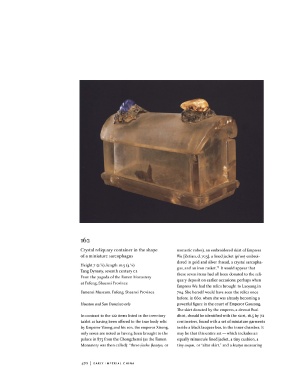Page 471 - The Golden Age of Chinese Archaeology: Celebrated Discoveries from the People’s Republic of China
P. 471
l62
Crystal reliquary container in the shape monastic robes), an embroidered skirt of Empress
of a miniature sarcophagus Wu [Zetian, d. 705], a lined jacket (pi'ao) embroi-
dered in gold and silver thread, a crystal sarcopha-
Height 7 (2 7s), length 10.5 (4 Vs) gus, and an iron casket." It would appear that
1
Tang Dynasty, seventh century CE
these seven items had all been donated to the reli-
From the pagoda of the Famen Monastery
quary deposit on earlier occasions, perhaps when
at Fufeng, Shaanxi Province
Empress Wu had the relics brought to Luoyang in
Famensi Museum, Fufeng, Shaanxi Province 704. She herself would have seen the relics once
before, in 660, when she was already becoming a
Houston and San Francisco only powerful figure in the court of Emperor Gaozong.
The skirt donated by the empress, a devout Bud-
In contrast to the 122 items listed in the inventory dhist, should be identified with the skirt, 16.5 by 7.2
tablet as having been offered to the true body relic centimeters, found with a set of miniature garments
by Emperor Yizong and his son, the emperor Xizong, inside a black lacquer box, in the inner chamber. It
only seven are noted as having been brought to the may be that this entire set — which includes an
palace in 873 from the Chongzhensi (as the Famen equally minuscule lined jacket, a tiny cushion, a
Monastery was then called): "three jiasha (kasaya, or tiny anqun, or "altar skirt," and a kasaya measuring
470 E A R L Y I M P E R I A L C H I N A

